When Vermont resident Bill Laberge decided he wanted to try a new career after 26 years as a custom furniture maker, he turned toward the sun.
A longtime volunteer at his state’s annual clean energy festival, Laberge, who lives in Dorset, earned his certification to perform solar installations, and eventually started his own business, Grassroots Solar.
“Doing solar seemed very much in line with my perspective,’’ he said.
His timing couldn’t be better. This year, Grassroots Solar announced partnerships with SunPower, a leading U.S. rooftop solar company, and sonnenBatterie, a German storage company, allowing Laberge to provide his customers with both solar technology and innovative battery backup — and he’s also capitalizing on a Vermont’s push for consumers to use cold-climate heat pumps and switch to electric cars.
“We just did a system for a couple who only required 24 panels to cover their current needs, but [who knew they’d] eventually put in cold-climate heat pumps and electric cars,’’ Laberge said. “We put in 36 panels — more than they need now — and they are selling the excess to one of their neighbors.”
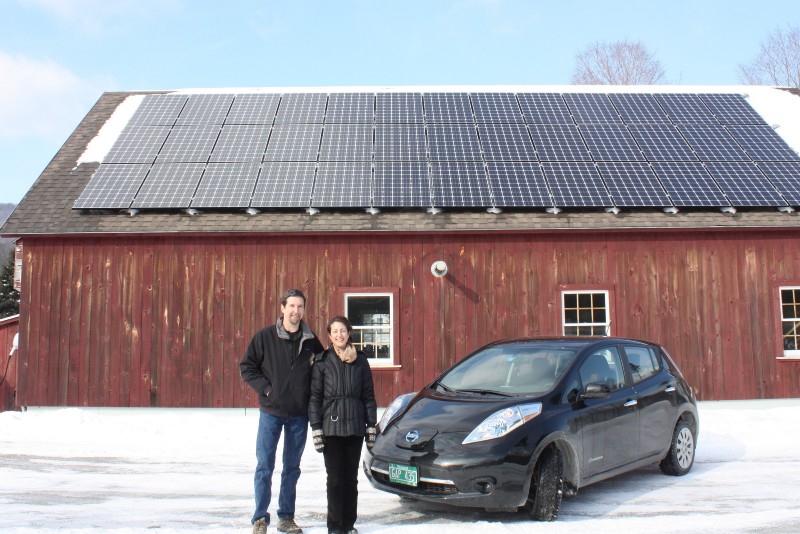
This story isn’t unique to Vermont. Laberge and other entrepreneurs are part of a larger trend toward clean energy that is underway across the Northeast. That trend is largely being driven by the Regional Greenhouse Gas Initiative (RGGI), a coalition of nine states — New York, Massachusetts, Vermont, Rhode Island, New Hampshire, Maine, Maryland, Delaware and Connecticut — that was established in 2005 as the nation’s first carbon trading market.
RGGI member states limit carbon dioxide emissions from the power sector by auctioning off emissions allowances. The money from the auctions goes back into energy efficiency programs, consumer rebates, and clean energy projects. RGGI funds have helped Vermont set up energy efficiency rebates and incentives through the local utilities. Now, homeowners are cutting their energy usage and signing up for solar — sold by small business owners like Leberge.
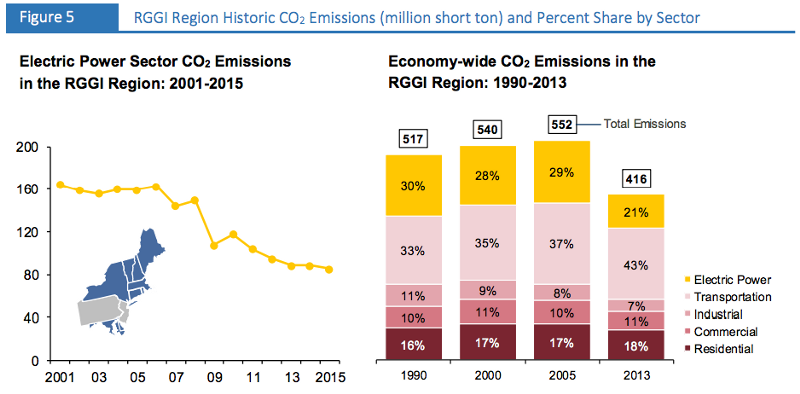
To achieve its energy and emissions reduction goals, the Northeast benefits from several factors, including traditionally high electricity prices and the fact that the region doesn’t produce much fossil fuel, other than shale gas in Pennsylvania, said Carl Pope, former executive director of the Sierra Club and a principal at Inside Straight Strategies, a sustainability consulting firm.
“There is no substantial local lobby against clean energy,’’ he said, unlike in California, also a leader in renewable energy generation. “[California] has a big local oil industry to fight back when it tries to move too quickly.’’
The Northeast also has “a knowledge-based economy,’’ which helps it transition to new industries, Pope said.
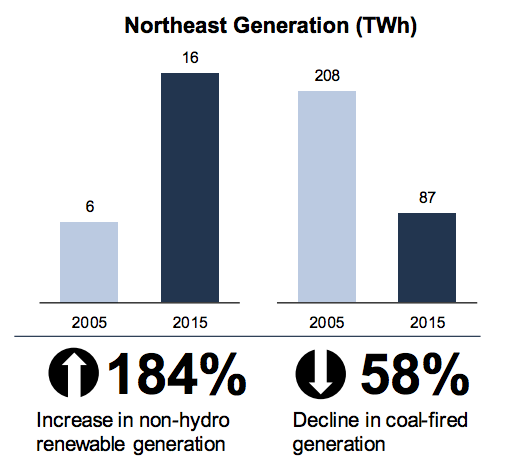
Multiple RGGI states have experimented with additional energy strategies. For instance, New Jersey’s largest utility, the Public Service Electric and Gas Company, met mandated renewable energy goals in part by putting solar on telephone poles.
In Rhode Island, the first commercial U.S. offshore wind project, the Block Island Wind Farm — a 30-megawatt, five-turbine wind farm — will be online soon, supplying most of Block Island’s electricity needs. Massachusetts recently approved a new law requiring utilities to procure 1,600 megawatts of offshore wind by 2027. And in Maine, the increasing use of battery technology is easing the strain on transmission systems.

“We see lots of momentum coming from changes that are taking place in all of these states,” said Christopher Van Atten, senior vice president of M.J. Bradley & Associates, an energy and environmental consulting firm that recently released a report exploring these rapid advancements.
What is happening in the Northeast is “not just a story about solar or about batteries,’’ Van Atten said. “It’s about all the innovative technologies that are now available, and the convergence of those technologies. And they are changing the way consumers interact with the electricity grid.’’
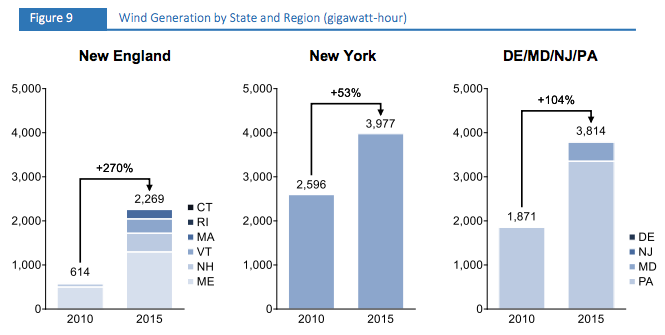
New York and New England, in particular, have undergone huge changes in the last ten years, according to the M.J. Bradley report. Between 2005 and 2015, coal-fired generation declined more than 80 percent in New England and New York, and more coal plants are scheduled to close.
Meanwhile, solar power in New York State has grown 750 percent in the past five years, according to Richard Kauffman, chairman of energy and finance for New York State and a former senior advisor to the U.S. Secretary of Energy.
Superstorm Sandy, which knocked out power to many New Yorkers four years ago, prompted the state to draft a comprehensive energy strategy “to build the grid of tomorrow, starting today,’’ Kauffman said.
“Gov. Cuomo lived among many cold and miserable New Yorkers, who waited many days for power to be restored,’’ Kauffmann said. “He then said that utilities were like vinyl records in the age of the iPad.’’
In Pennsylvania, New Jersey, Delaware, and Maryland, similar changes in the fuel mix have taken place, “although several of these states still have significant coal generation,’’ the report says. Coal now makes up an estimated 24 percent of the area’s electricity source. At the same time, natural gas has grown and now represents more than 30 percent of total electricity generation.
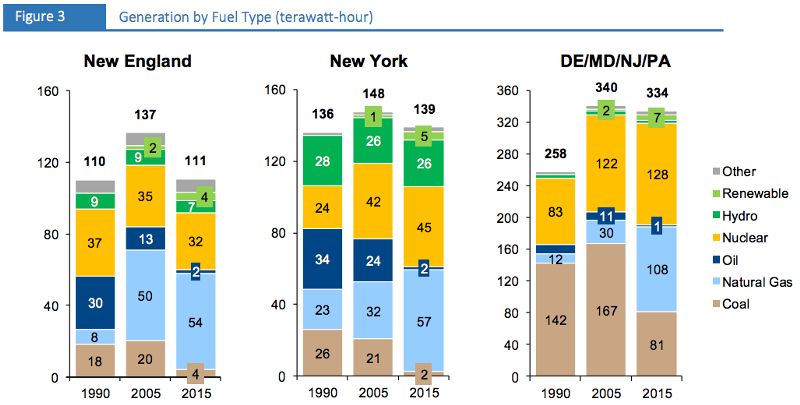
RGGI provides a backbone for reducing emissions. Under the RGGI program, “people have to pay for the right to pollute, which creates an incentive not to pollute,’’ said Peter Kelly-Detwiler, co-founder of Northbridge Energy Partners, an energy consulting firm.
“To get to a decarbonized environment, it gets harder as you get to the last mile,’’ he said. “But the good news is that innovation is accelerating, and the world is becoming increasingly comfortable with non-traditional generation, like solar, wind and batteries. Global competition is driving renewable energy prices down, and the Northeast is a microcosm of what’s happening everywhere.’’
Kelly-Detwiler predicts much of this movement will spread elsewhere in the coming years. “The left and the right coasts develop, and it bleeds into the rest of the country.”
He also believes that the increasing acceptance of renewables will produce surprising support from unexpected sources. In fact, it’s already happening. He recalled, for example, a conversation he overheard recently while in a Boston area bar.
“This guy, who was clearly blue-collar and someone who didn’t strike me as especially left-leaning, was boasting to another guy in the bar about how he had put solar panels on his roof and how much money he was saving,’’ Kelly-Detwiler said. “And I said to myself: ‘the revolution is here.’’’
Marlene Cimons writes for Nexus Media, a syndicated newswire covering climate, energy, policy, art, and culture.

